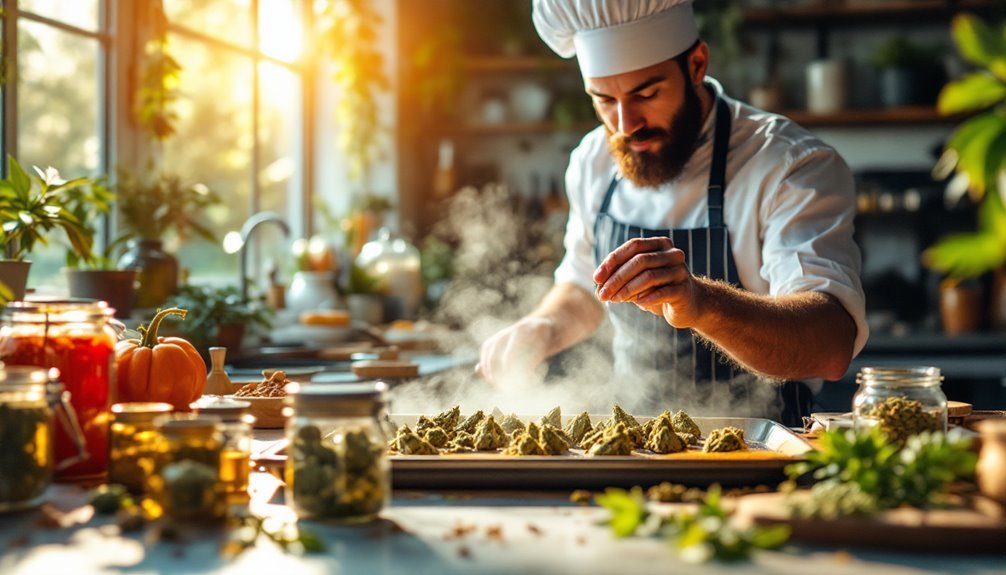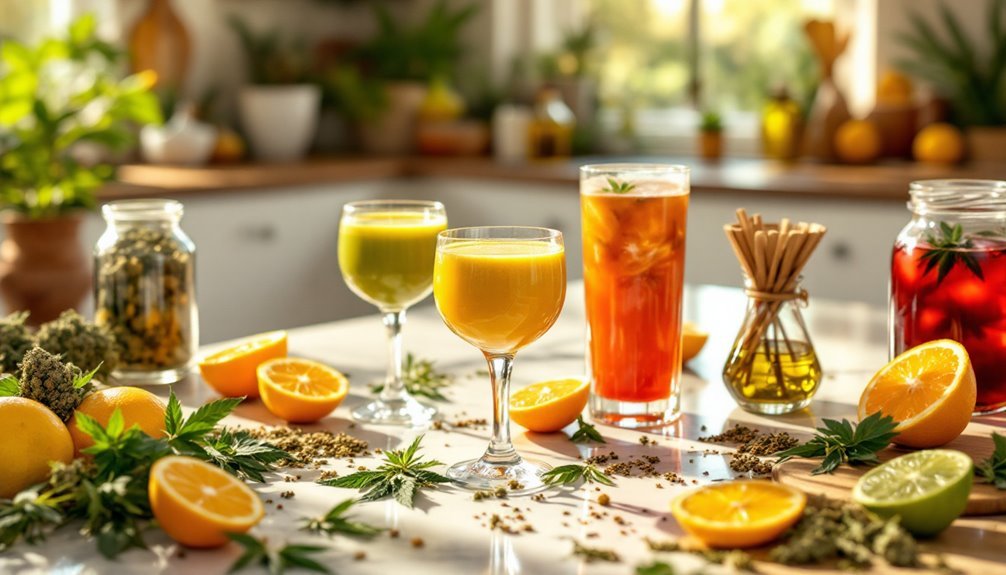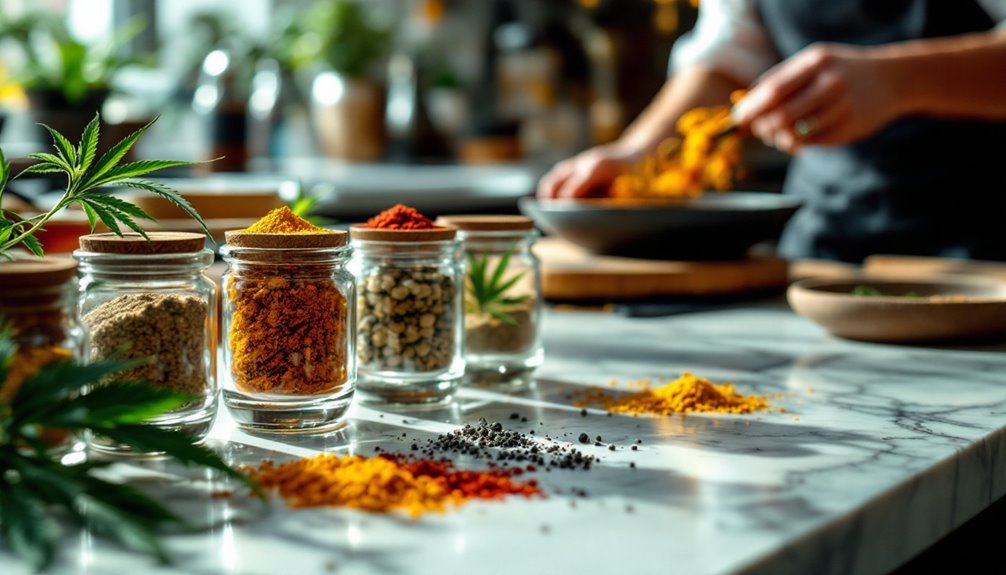Experience the fascinating world of cannabis cooking with this eclectic recipe collection. It’s not just about brownies anymore; you can elevate your culinary skills with infused oils, butters, and more. From sweet treats to savory delights, the possibilities are endless. Understanding the decarboxylation process and mastering dosage are key to crafting potent, flavorful dishes. Ready to explore new flavors and techniques that could transform your kitchen creations?
Decarboxylation Process: Activating Cannabis for Cooking

When you’re planning to cook with cannabis, understanding the decarboxylation process is crucial for unlocking its full potential. This process transforms non-psychoactive compounds like THCA and CBDA into active THC and CBD, essential for effective edibles. You’ll need heat and time—ideally, set your oven to 220°F (104°C) for 30-40 minutes. Avoid temperatures above 300°F (149°C) to preserve valuable cannabinoids and terpenes. Opt for methods like the oven, stovetop, or sous vide for consistent results. Some decarboxylation happens during the drying and curing of cannabis, but heat is necessary to complete the transformation. Grind the cannabis first for even heating, and use an oven thermometer to maintain accuracy. Keep an eye on it to prevent burning, and ensure proper ventilation due to the potent aroma. Once finished, your cannabis should be light golden brown and ready for culinary adventures.
Mastering Cannabis-Infused Oil and Butter
Creating cannabis-infused oil and butter is an essential skill for any culinary enthusiast looking to explore the world of edibles. Start by decarboxylating your cannabis for maximum potency. Use a 1:1 ratio of cannabis to butter, melting it on low heat with water to maintain the perfect temperature between 160-200°F. Simmer gently for 2-3 hours, then strain with a mesh strainer or cheesecloth, being careful not to squeeze out excess butter. This prevents chlorophyll contamination.
For infusion, try methods like stovetop, Instant Pot, or double boiler, ensuring you don’t exceed 200°F to preserve cannabinoids. Enhance effects with optional lecithin. Decarboxylation is vital because it converts THCA into THC, which is necessary for activating the cannabis effects. Once cooled, drain excess water and store your cannabutter in the fridge or freezer for future culinary adventures.
Baking With Cannabis: Sweet Treats and More

While the world of cannabis edibles offers a variety of options, baking with cannabis-infused ingredients brings a special kind of delight. You can whip up classic favorites like brownies, which have long been a staple in cannabis baking. Try experimenting with cookies in flavors like chocolate chip, butterscotch oatmeal, or peanut butter. When using cannabis in baking, it’s essential to decarboxylate to activate the psychoactive effects of THC. Soft, chewy cannabis sugar cookies and cut-out sugar cookies also make delicious treats. If you’re looking to expand your culinary creativity, try cannabis buttercream frosting on easy cupcakes or indulge in cannabis peanut butter blossoms. For something unique, create cannabis-infused doughnuts with strawberry, maple, or chocolate glazes. Feel free to explore different strains and THC-CBD ratios to tailor your baked goods to personal preferences and desired effects.
Sautéing With Cannabis: Elevating Savory Dishes
To elevate your savory dishes with cannabis, begin by mastering the art of sautéing with cannabis-infused fats. First, decarb your cannabis to activate the THC and CBD by baking it at 220°F for 30–40 minutes. Once cooled and ground, infuse it into butter or oil. Use this infused fat in place of regular oil or butter. Sauté onions and garlic with cannabis-infused oil for a flavorful base, or drizzle it over guacamole. It’s important to know the THC/CBD content of your cannabis products to ensure proper dosage and potency when cooking.
| Dish | Infused Ingredient | Cooking Tip |
|---|---|---|
| Cannabis Chicken Wings | Infused oil and butter | Mix with hot sauce for coating |
| Guacamole | Drizzle infused oil | Enhance with lime and cilantro |
| Pasta Sauce | Sauté with infused oil | Add tomatoes and spices |
Adjust the amount of infused fat for your desired potency. Enjoy the enhanced flavors!
Creating Cannabis-Infused Beverages

After mastering savory dishes with cannabis-infused fats, you’ll want to explore the world of cannabis-infused beverages. Start with a refreshing watermelon mojito by muddling seedless watermelon cubes and fresh mint. For a tropical twist, blend frozen pineapple chunks with coconut milk for a THC pina colada. Don’t forget lime and ginger beer for a zesty cannabis-infused Moscow mule. Use a blender or food processor to achieve smooth textures, and a strainer for separating solids. Add decarboxylated cannabis for potency, adjusting the amount to your tolerance. Remember that decarboxylation is necessary to activate THC and CBD from THCA and CBDA, ensuring the effectiveness of your cannabis-infused drinks. Infused simple syrups and tinctures help maintain consistent THC dosing. Remember, selecting the right strain affects the beverage’s impact, so choose wisely between indica for relaxation or sativa for energy. Enjoy responsibly!
Storing and Serving Cannabis-Infused Foods
When it comes to storing cannabis-infused foods, using proper techniques ensures freshness and potency. Store them in airtight containers in the refrigerator at 4°C (40°F) or below, labeling each with the preparation date. Most items, like marijuana brownies and butter, last 1-2 weeks. For longer storage, freeze portions individually wrapped in waxed paper, placing them in airtight freezer bags. Keep the freezer at -18°C (0°F) or below, where they maintain potency for up to 6 months. For dry edibles, use high-quality airtight containers, ensuring the food is cool and dry. Store them in a cool, dark place to protect cannabinoids from light and heat. Always label everything clearly and keep these foods away from children and pets. Effective methods for storing cannabis-infused foods include refrigeration and freezing, which preserve both freshness and potency over time.
Enhancing Flavor With Cannabis-Infused Seasonings and Spices

Harnessing the rich flavors of cannabis-infused seasonings and spices can elevate your culinary creations to new heights. Start by choosing the right cannabis for infusion. Decarboxylate your cannabis to activate THC or CBD, then mix it with your favorite spices. Consider paprika, turmeric, or chipotle peppers for added depth. Adjust the heat level with cayenne or Ancho peppers. Mix thoroughly for a consistent flavor. By storing your cannabis-infused seasonings in a mason jar, you can preserve their potency and flavor for up to 6 months, ensuring a delicious taste experience whenever you use them.
| Spice | Heat Level | Flavor Profile |
|---|---|---|
| Cumin | Mild | Earthy, Warm |
| Chili Pepper | Medium to Hot | Spicy, Pungent |
| Garlic | Mild | Savory, Pungent |
| Coriander | Mild | Citrus, Sweet |
Balance flavors by considering terpenes and complementing ingredients. Use cannabis-infused seasonings in versatile recipes like tacos or fajitas for a flavorful experience.
Managing Dosage and Safety in Cannabis Cooking
While preparing cannabis-infused dishes, managing dosage and ensuring safety is crucial to a positive culinary experience.
First, calculate the total THC/CBD content from the product label, and factor in a 10-20% potency loss during cooking. Divide this total by the number of servings to determine the dosage per serving. Use cannabis calculators for accuracy, and start with low doses, like 2.5-5mg of THC, especially for beginners. Decarboxylation is essential for activating the cannabinoids in your cannabis before cooking, as this process involves heating the cannabis to convert THCA to THC, which is psychoactive.
Understand that edibles have a delayed onset, taking 30 minutes to a couple of hours to affect. Wait 45-90 minutes before considering additional doses.
Store your creations in clearly labeled, child-proof containers, separate from regular food. In case of overconsumption, stay calm and hydrated.
Always respect local laws regarding cannabis use and homemade edibles.
Conclusion
In this captivating culinary collection, you’ve discovered the delightful dance of decarboxylation, dabbled in crafting cannabis-infused oils and butters, and dived into baking bliss with sweet treats. Sauté and sizzle savory sensations, sip on spirited sips, and sprinkle seasonings that sing with cannabis charm. Safely savor each creation by managing mindful doses. Now, you’re ready to spice up your kitchen with creativity and cannabis, crafting dishes that delight and dazzle every discerning diner.
